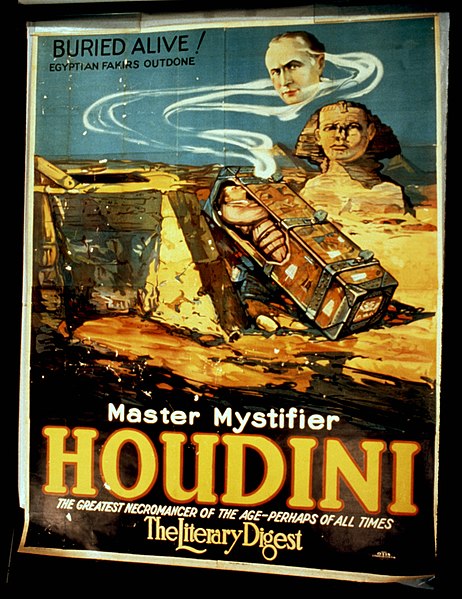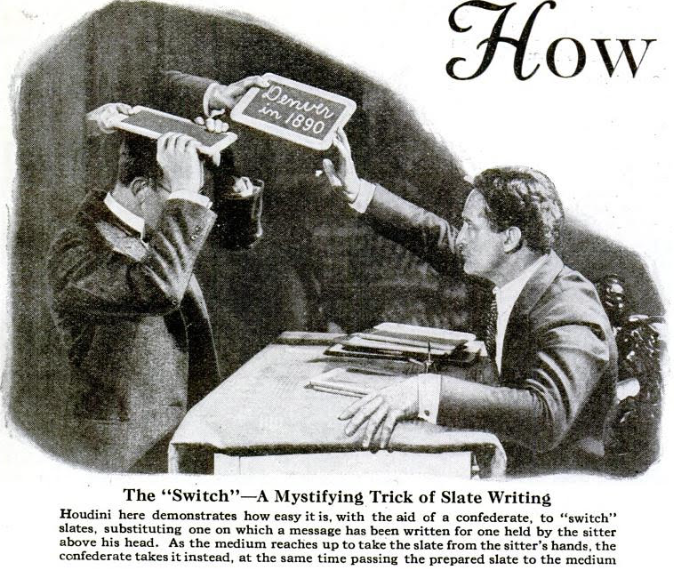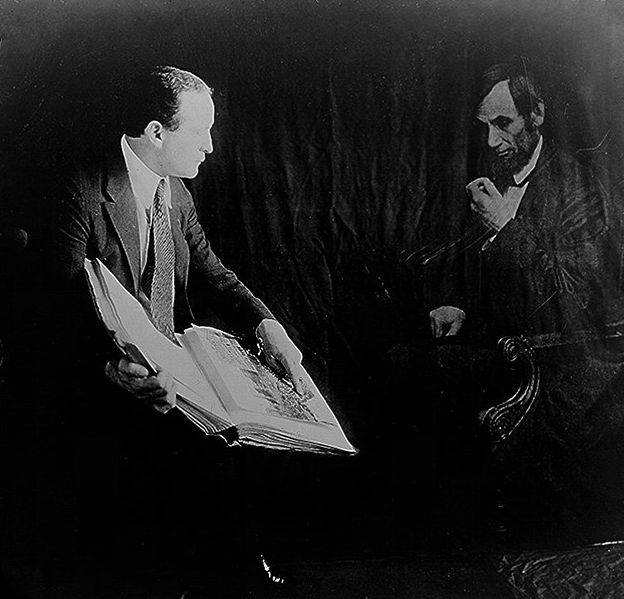Rosabelle: Harry Houdini
Harry Houdini died on Halloween 1926, at the age of only 52. The self-proclaimed "escapologist" died from peritonitis.

Harry Houdini, courtesy of the Library of Congress.
His death was all because of some gut punches thrown by a McGill University student named J. Gordon Whitehead.
Houdini had been in a reclining position in his dressing room, recuperating from a recently broken ankle and reportedly reading mail when Whitehead and his friend ushered themselves in.
Because Houdini had been bragging that he could take any strikes to his abdomen if he was able to brace himself first, Whitehead took him up on the challenge.
Under the impression that Houdini had, in fact, braced himself, Whitehead landed four quick blows to Houdini's unguarded torso.

Poster of one of Harry Houdini's shows, courtesy of the Library of Congress.
Houdini performed that night in gruesome pain, and for two days thereafter.
When he finally went to the doctor, he had a 102 °F fever and was told to go to the hospital immediately to remove his appendix. Instead, he decided to put in his show as planned.
By the time he began, his fever had escalated to 104 °F, and by the third act, he had collapsed behind the curtain. Even then, he couldn't be convinced to go to the hospital until the next morning. And then it was too late.
Houdini's alleged last words were, "I'm tired of fighting."
After his death, his friends claimed a variety of supernatural events, like his inscription vanishing from a book, and a bust of Houdini shattering without cause. But his wife, Beatrice ("Bess"), was still devoted and waiting.
And thus began a new Halloween tradition: the Houdini Seance.
Every year, on the anniversary of his death, a seance was held at the Knickerbocker Hotel in Hollywood by Houdini's widow. For 10 years, she waited for a sign from beyond the veil.
Spiritualism--you know, the seances and knocking and such--was the belief that the living could communicate with the deceased via a proxy or "spirit medium." It was the bee's knees in the 20s, and Houdini was having exactly none of that BS.
Houdini had a vendetta against spirit mediums. It was an animosity that developed after the death of his beloved mother in 1913.

Houdini with his mother and his wife, Bess, courtesy of the Library of Congress.
In earnest, he had turned to spirit communication, where he learned they were exploitative charlatans.
So he made it his purpose to expose them.
In the course of his crusade, Houdini debunked countless psychics; most notable was the famed medium Margery, also known as the Blonde Witch of Lime Street. Because of this, Houdini drew the repudiation of no less than Sherlock Holmes author Sir Arthur Conan Doyle, who was also an ardent believer in fairies. (No, seriously, though.)

From "Spirit Tricks," in Popular Science, December, 1925.
Margery had been presented to a panel of skeptics convened by Scientific American; they offered a $2,500 reward for a medium who could outwit them all.
They actually considered validating Margery, until Houdini was informed.
Enraged, he dropped all his shows and rushed to Boston to witness Margery's seance. He went on to expose all of her trickery, but his condemnation of her was not to be taken lightly--she was a celebrity medium, after all.
Rumor has it that Margery's spirit guide, "named" Walter, assured an audience in 1926 that Houdini would be dead by Halloween of the same year.

From "How I Unmask the Spirit Fakers," Popular Science, November, 1925.
Walter was not wrong.
Having been dead-set on his vendetta, Houdini had devised an elaborate code with his wife, Bess, to disprove his own ghostly presence, if he died first.
If an afterlife existed, he'd come back, and the code would ensure Bess wasn't being swindled.
Despite how this story has so often been spun, this was, in this writer's opinion, not a romantic gesture: Houdini was a vehement anti-spiritualist and a famously vain man. He would prove there was no afterlife, even in death.

Houdini disproving spirit photography with the "ghost" of Abraham Lincoln, 1920s. Courtesy of the Library of Congress.
That isn't to say the Houdinis weren't close (though they had their difficulties. Trust me.) How they met is still up for debate because they kinda loved to mindf ck people, but all the stories are charming regardless. Harry's brother said they met because he was dating her first, while they were performing.
Bess said they met when Houdini spilled something on her dress during a magic act at her school. Houdini himself said he "eloped with [Bess] out of her schoolbooks." At one point, while drinking, Bess reportedly told a friend that she "sold her virginity to Houdini for an orange."

Houdini (seated) with his brother "Hardeen," circa 1901.
In 1929, a medium named Arthur Ford claimed to have successfully channeled Houdini's ghost, and arranged a seance with Bess for January 8. Ford apparently successfully used the code, and he even had Bess sign a witness statement on her own stationary (though "not in her own hand.")
She even gave an enthused interview to the New York Times.
Bess, however, was recuperating from a fall down a flight of stairs and was heavily medicated (and by some accounts, an alcoholic.)
As it was reported that Houdini had at last returned from the grave, the skeptics rushed in. They claimed that Bess sold the code to Ford ahead of time, or that she just wanted fame.
Eventually, a now-sober and much-pestered Bess recanted her belief in Ford's message.
The code had apparently been revealed to a reporter the year before OR written in a book OR reported to Sir Arthur Conan Doyle, and Arthur Ford had (unlike his contemporaries) done his research.
Upon Ford's death in 1971, his executor found proof that the Houdini seance was faked, as well as his extensive files of research on his other clients.
The Ford debacle aside, every Halloween, for ten years, Bess held a seance to reach her husband in the afterlife.
The so-called Final Seance was held on the roof of the Knickerbocker Hotel in L.A., and was broadcast on the radio. For an hour, they tried to summon Houdini, complete with desperate outcries.
At the end of the hour, Bess announced, "Houdini did not come through. My last hope is gone. I do not believe that Houdini can come back to me, or to anyone. The Houdini Shrine has burned for ten years. I now, reverently turn out the light," she said, snuffing the candle she had kept lit for a decade. "It is finished. Good night, Harry!"
Bess retired from the Houdini Seance in 1936--she famously stated that "ten years is long enough to wait for any man"--but the tradition continues officially AND unofficially to this day.
Bess Houdini died in 1943. She was buried against her wishes in a separate cemetery than her husband, because they were of differing faiths. (He, Jewish; she, Catholic.)
So what was the code?
It had been used by the Houdinis regularly in their mind-reading acts, and was a phrase made like this: a series of words, each one representing a letter, which thus created a word.
When finished--if correct--the code was, "Rosabelle, b-e-l-i-e-v-e."
Rosabelle was the song that Bess and Harry sang in their first performance together... or the song she sang when he fell in love with her during her performance on Coney Island.

Poster advertising Harry and Bess Houdini by Liebler & Maass, circa 1895. Courtesy of the Library of Congress.
You know, depending on who was telling the story, and when.
share
